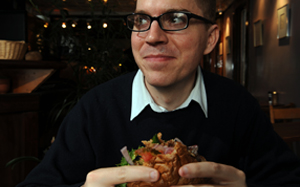Jason Matheny (New Harvest) et la viande in vitro
Future fillet
Jason Matheny envisions the day when beef and chicken grown in labs will help prevent heart attacks and protect the environment—if enough people swallow the concept.
By Josh Schonwald
Photography by Dan Dry
The leader of the in vitro meat movement slowly chewed what looked vaguely like a chicken drumstick.
After a few bites, Jason Matheny, AB’96, turned to me, nodded approvingly, and noted the ingenuity.
It wasn’t a chicken drumstick—it was soy fiber tied around a wooden stick.
The owner of the Java Green Eco-Café, a tiny restaurant in downtown Washington renowned among faux-meat connoisseurs, then brought out several more facsimiles—a spicy sausage dish, Korean barbecue, and a grilled chicken on ciabatta sandwich, which he boasted “many people prefer over real meat.”
Matheny, a slim 34-year-old, peered at the soy creations through his black-framed glasses.
“The challenge has always been to get that moist fiber you get in meat,” he said between chews.
Java Green impressed him. “Mock meat is getting better and better.”

It wasn’t until 45 minutes later, in the frozen-food section of a Whole Foods Market near DuPont Circle, that Matheny started revealing why mock meat was not enough—and why he has spent much of the past five years promoting a radically different approach.
There could be a limit with fake meats, he explained, standing before a freezer stuffed with veggie burgers, soy chicken nuggets, and vegan-friendly meatballs. “Meat tastes great. Meat has unique properties,” said Matheny, who hasn’t eaten the stuff in more than two decades.
“Maybe they’ll never be able to match the taste and texture of real meat with mock meats. Some consumers might not be satisfied with soy or mycoprotein” (made from an edible fungus). He paused.
“We just can’t put all of our eggs in one basket.”
It was this basic idea—the need for an alternative to vegetarian alternatives—that ultimately led to Matheny’s provocative proposal.
Critics call it “disgusting,” “gross,” “a Frankenfood nightmare”; others see it as a potential humanitarian and environmental panacea, saving lives and land.
Matheny’s vision, first articulated in the May/June 2005 Tissue Engineering, was that meat could be grown rather than raised.
Chicken, pork, and beef would be produced in vitro, in a cell culture. Industrial-scale, test-tube meat factories would, Matheny hoped, challenge and eventually replace traditional livestock farming.
Matheny was not the first person to envision in vitro meat as a potential food source—the idea is at least 70 years old.
But no one, certainly in the United States, has done more to promote the concept.
Not only did he coauthor the seminal paper, but in 2004 he founded New Harvest, the world’s first nonprofit organization dedicated to supporting in vitro meat research.
As director of New Harvest, headquartered in his Baltimore apartment, he’s effectively the chief fund-raiser, grants administrator, Web-content developer, and spokesperson for the in vitro meat movement.
In this role Matheny has become a minor media star.
It was Matheny who told the Baltimore Sun that compared to “real” meat, made from cattle fed growth promoters and antibiotics, in vitro meat “will be the purest meat ever.”
It was Matheny who introduced the “Jurassic ParkChristian Science Monitor (“meat could be produced from the DNA of extinct animals”) and who predicted in Beef magazine “that perhaps the future farmers of America are microbiologists rather than cattle ranchers.”
And it was Matheny who told me in January, at Whole Foods Market on P Street, that a minced-meat product, produced in vitro, would be available to consumers between “five and ten years from now,” and that this commercial meat would likely have the “fat profile of salmon or an avocado.”
He explained: “You can engineer the fat content to have good fatty acids, Omega 3s, instead of the Omega 6.”
But was this prediction realistic or a sci-fi fantasy?

When Michael Jacobson, AB’65, then director of the Center for Science in the Public Interest, heard about the idea four years ago, he dismissed it, telling a Baltimore reporter, “It’s silly to even conjecture. It’s so far into the future.” But when I asked Raphael Lee, professor of plastic surgery, dermatology, molecular medicine, and organismal biology—and an expert on tissue growth—about the feasibility of in vitro food, he responded, “Very possible.” Lee, a pioneer in culturing tissue in a lab, added: “Theoretically, it’s a lot easier to do this than engineering muscle to insert into the body.”
Matheny is not a cell biologist, a bioengineer, or an animal scientist. In fact, the coauthor of “In Vitro–Cultured Meat Production” has no formal training in tissue growth.
Now a doctoral student in health economics at Johns Hopkins, he majored in art history.
Not long after he visited a farm in Kentucky on a middle-school trip and saw the way animals were treated—“It wasn’t like Old MacDonald’s farm”—Matheny became a vegetarian.
In college, after reading Princeton bioethicist Peter Singer’s argument that it was morally indefensible for people with the means not to give 5 or 10 percent of their income to charity, Matheny committed himself to a much higher level of tithing: 60 to 80 percent of his annual income.
He gets most of his clothes at thrift stores, buys used books, tries to find the cheapest apartment possible—he once lived in a $100-a-month apartment in Oakland.
When Matheny explains how he became interested in growing meat, he begins on a chicken farm in India.
The influence of Singer, other moral philosophers such as Jeremy Bentham and John Stuart Mill, and an internship at the Berkeley-based Seva Foundation had inspired him to enter Johns Hopkins’s graduate program in public health, a field whose credo is “to minimize suffering in the world.”
During his second year, he spent six months in India to evaluate an HIV-prevention program. In October 2003 he toured a farm outside Delhi.
It was huge; with thousands of birds in cramped metal sheds, the odor was noxious.
He had seen factory farming before, but this was India, whose diet had for centuries been mainly vegetarian.
During his travels he spotted more industrial-sized chicken farms and saw why they were there. “Walk into any McDonald’s, and you’d see tons of people eating chicken sandwiches.”
When he returned to the States, he found statistics confirming his observations. Poultry consumption in India had doubled in the previous five years.
And it wasn’t just India: in China meat demand was doubling every ten years. Matheny considered the toll of skyrocketing meat consumption—the millions of acres of land needed, the water use, the fossil fuels required to power industrial-scale animal farms.
Then there was animal waste and the mounting evidence that livestock production is a major source of greenhouse-gas emissions.
Doing the math, he thought, “It just wasn’t sustainable in 50 years.”
Adding to his alarm, Matheny didn’t believe, like some in the environmental and public-health communities did, that the message would work—that people would be persuaded by the environmental logic of a vegetarian diet, or the health argument (a plant-based diet reduces the risk of heart disease, obesity, diabetes), or humanitarian concerns about animal treatment.
“Only 1 or 2 percent of Americans are vegetarian. None of these messages was having a measurable impact.”
Moreover, he felt an urgency: “There’s not enough time to wait for a massive dietary transition.”
So he turned to technology.
Ever since he attended a 2001 Berkeley lecture series on the energy crisis, Matheny has believed that instead of getting people to take fewer showers or drive less, it was most effective to satisfy existing needs with more efficient technologies, like hybrid cars or the compact fluorescent light bulb, which has begun to replace the energy-hogging incandescent bulb.
“What we needed was the compact fluorescent light bulb for meat production.”
In his search for the carnivore’s green tech, Matheny learned about several promising approaches.
Meat substitutes were not new—Buddhist cuisine had featured meat substitutes such as tofu for centuries—but a recent improvement in soy-processing technology, called extrusion cooking, made it increasingly possible to mimic meat.
Technology also improved the taste of mycoprotein, and microbiologists made strides in farming algae, a high-protein source grown in saltwater.
During his research Matheny read a news item online about a NASA-funded project.
A team of researchers, led by bioengineer Morris Benjaminson, had grown chunks of goldfish meat while exploring a new food source for astronauts on long-range space missions.
Benjaminson believed that the meat, grown from live-muscle cells and placed in a nutrient broth, could be an alternative to plant-based protein sources.
Fascinated, Matheny dove deeper.
He soon learned that the idea of culturing animals as a food source was not new.
In fact, in a 1932 essay Winston Churchill suggested that it would be more efficient to cultivate wings and breasts in a growth medium than to raise an entire chicken.
He had been inspired by the Nobel Prize–winning surgeon Alexis Carrel, who in his lab kept a piece of chicken-embryo heart muscle alive for more than 30 years.
Matheny also learned about a more recent instance when humans actually ate in vitro meat: in 2003 a pair from the University of Western Australia grew two quarter-sized frog steaks in vitro, sautéed them in a honey-garlic sauce, and served them as part of an art performance.
Four of the eight diners spit it out.
Matheny recognized that there was a major “yuck factor.”
Still, while large corporations were spending millions researching plant-based meat substitutes, he wondered why no one was looking at cultured meat.
Also, although he hoped currently available mock meats—those made from soy, gluten, or mycoprotein—would eventually achieve a perfect replica of real meat, he feared the technology would hit a wall.
It was a challenging task to wean humans off of meat, he thought.
“Our taste buds have evolved to like the taste of things like sugars, fat, and meat, which were important in our ancestral environment.”
Many people would be hard to shift to mock meats, he reasoned, but some might be willing to accept a cultured meat product.
Matheny studied the technology that had inspired the NASA project. He found about two-dozen papers on tissue growth in humans and animals.
He then wrote more than 60 of the authors cited—the world’s experts in muscle-tissue engineering—with a simple query: “Can this be tested as a food idea?”
Many responded with generous feedback, and three were so curious about the graduate student’s idea that they offered to coauthor a paper—Vladimir Mironov, a tissue engineer at the Medical University of South Carolina; Pieter Edelman, a cell biologist at Wageningen University in the Netherlands; and Douglas McFarland, an animal scientist at South Dakota State University.
Together, Matheny and the three scientists wrote a paper laying out, for the first time, a theoretical process to produce in vitro meat on a large scale.
The team identified several key steps to culturing meat.
First, cells—specifically precursors of muscle cells, called myoblasts, that proliferate quickly—would be selected from biopsies of chickens, turkeys, pigs, lamb, cattle, or other animals.
Next the selected cells would be put in a growth medium—a vat of nutrient-rich soup, including carbohydrates and amino acids, that fosters rapid cell growth.
Here the cells proliferate into millions.
Then the millions of cells would be poured into a bioreactor, essentially a large fermentation chamber.
The cells would fuse to become muscle fibers that would create thin sheets of meat.
For the final step, the team offered two approaches.
To achieve the taste and feel of real meat, the cultured product had to be exercised, like real animals.
(The Australian effort had skipped this step, creating frog steaks with a texture one person described as “reminiscent of snot.”)
One approach was to hang the thin sheets of freshly spawned meat on polymer scaffolding—the sheets would be moved mechanically every ten minutes to stimulate movement.
After being grown and stretched, the meat sheets would be stacked to increase thickness.
In the second approach, the meat would be grown on small, edible beads that would stretch the meat with changes in temperature.
The paper received favorable feedback during peer review, but Matheny hadn’t anticipated the public interest it would provoke.
Almost immediately, reporters started calling.
By the end of 2005, he had not only been interviewed by the New York Times Magazine, Washington Post, and Der Spiegel, but he’d also appeared on the CBS Evening News, NPR, and the PBS program NOVA scienceNOW.
Discover magazine named “Lab Grown Meat” one of its best science stories of 2005.
People were embracing the idea, as Matheny had hoped, as an energy-efficient, waste-reducing, water-saving, morally sound meat alternative.
But the most important response came that spring.
Even before the paper was published, the Netherlands’ government, which learned of the paper during peer review, had invited Matheny to discuss his in vitro meat idea at a meeting of the country’s agricultural officials.
Matheny didn’t know it, but the Dutch government had received a proposal from a scientist who wanted to do lab research on in vitro meat.
A few months after his visit, Matheny got an e-mail from Henk Haagsman, a professor at Utrecht University; the government had granted his team 2 million euros and four years to study the proposal.
“It was my happiest moment,” Matheny said. “We actually had a chance to see if this could work.”
Four years later the in vitro meat vision is closer to reality.
Haagsman’s team has applied for a grant extension and is making progress.
“They could make a burger right now,” Matheny said, “but it would cost thousands of dollars per pound.”
Although the Dutch project is the only effort underway to develop commercially viable in vitro meat, others are examining the technology.
The In Vitro Meat Consortium, which Matheny helped create to exchange knowledge on related research, held its first conference in Norway last year.
Corporate investors, including Silicon Valley venture-capital firm Kleiner Perkins, have looked closely at in vitro meat as a possible green-tech investment.
And although New Harvest hasn’t seen a windfall of funds, the organization is funding a soon-to-be-completed research project: an Oxford biologist is comparing the energy use of cultured meat with conventional meat production.
Although Matheny has devoted so much time and thought to in vitro meat and is closely associated with the idea, he sees an end to his role.
“I want to make it happen,” said Matheny, who looks forward to eating a juicy, lab-grown burger. “But once I get it commercially viable, I should move on.”
He’s still, after all, a PhD student in health economics.
He’s written papers on risk analysis, biotechnology, moral philosophy, bioterrorism, and bioethics.
Even with his in vitro meat evangelizing, he works as a consultant for clients such as the Center for Biosecurity, the Applied Physics Laboratory, and the World Bank.
And he has other concerns. The day after we ate faux meat in DC, he e-mailed me another paper.
This one, inspired by Law School senior lecturer Richard Posner’s 2004 book Catastrophe and published in the October 2007 Risk Analysis, was titled “Reducing the Risk of Human Extinction.”
It included a cost-benefit analysis of strategies for, among other things, deflecting asteroids. For Matheny, it’s another step in his crusade to protect the planet.
Josh Schonwald, a meat eater who works in the University’s News Office, is writing a book about foods of the future.
Faculty chew on cultured meat
By Josh Schonwald
Whatever it’s called—test-tube meat, in vitro meat, cultured meat, lab-grown meat—Jason Matheny’s plan has provoked a wide range of responses.
Among Chicago faculty the reactions are similarly diverse.
“The whole idea is not so appetizing,” says Pamela Martin, AB’89, assistant professor in geophysical sciences.
Martin coauthored a 2006 paper that compared the global-warming effect of omnivores with that of vegetarians, finding that the typical American meat-heavy diet produces higher levels of greenhouse-gas emissions than a plant-based diet.
Matheny points to that paper as evidence for the environmental consequences of conventional meat production.
But Martin, who has also evaluated the energy costs of agricultural production, questions whether in vitro meat production would be efficient. “It sounds like an energy-intensive process to me.”
Her coauthor on the Earth Interactions article “Diet, Energy, and Global Warming,” Gidon Eshel, a former U of C geophysicist now at the Bard College physics department, agrees that in vitro meat’s energy efficiency has yet to be proved.
He disputes Matheny’s contention that humans have a “craving” for meat—that people simply cannot make a dietary change. Still, Eshel says, “If it reduces greenhouse-gas emissions, I’m for it.”
Martha Nussbaum, the Ernst Freund distinguished service professor of law and ethics, and coeditor of the 2005 anthology Animal Rights, has a clear take on in vitro meat.
“It sounds like a great idea to me,” she says.
“I don't like meat very much, so I might or might not eat it, but the humane issue is of immense importance, and I think that this would be a wonderful way of resolving this grave moral issue.”
Medical Center plastic surgeon Raphael Lee, an expert in burn trauma and bioengineering who’s worked on tissue growth, is also enthusiastic about the idea.
The plan is not only technologically feasible, he says, but also could help reduce illness.
In Darfur, Chad, and other developing countries Lee has studied, food-borne pathogens are a major source of disease.
Although he’s not familiar with the specifics of Matheny’s cultured-meat–growing proposal, Lee says, “Theoretically, it could be a huge improvement.
This is a controlled process in a controlled environment. It could be much safer process than conventional means.”
http://magazine.uchicago.edu/0906/features/future_fillet.shtml









